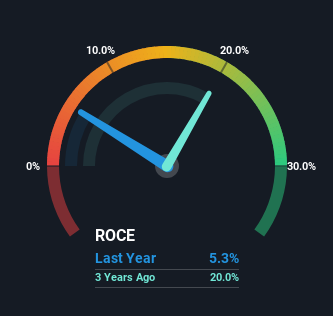- India
- /
- Professional Services
- /
- NSEI:SPECTSTM
Returns On Capital At Spectrum Talent Management (NSE:SPECTSTM) Paint A Concerning Picture
What trends should we look for it we want to identify stocks that can multiply in value over the long term? Firstly, we'd want to identify a growing return on capital employed (ROCE) and then alongside that, an ever-increasing base of capital employed. Basically this means that a company has profitable initiatives that it can continue to reinvest in, which is a trait of a compounding machine. Having said that, from a first glance at Spectrum Talent Management (NSE:SPECTSTM) we aren't jumping out of our chairs at how returns are trending, but let's have a deeper look.
What Is Return On Capital Employed (ROCE)?
Just to clarify if you're unsure, ROCE is a metric for evaluating how much pre-tax income (in percentage terms) a company earns on the capital invested in its business. The formula for this calculation on Spectrum Talent Management is:
Return on Capital Employed = Earnings Before Interest and Tax (EBIT) ÷ (Total Assets - Current Liabilities)
0.053 = ₹79m ÷ (₹2.0b - ₹515m) (Based on the trailing twelve months to March 2024).
So, Spectrum Talent Management has an ROCE of 5.3%. In absolute terms, that's a low return and it also under-performs the Professional Services industry average of 12%.
See our latest analysis for Spectrum Talent Management

While the past is not representative of the future, it can be helpful to know how a company has performed historically, which is why we have this chart above. If you want to delve into the historical earnings , check out these free graphs detailing revenue and cash flow performance of Spectrum Talent Management.
So How Is Spectrum Talent Management's ROCE Trending?
On the surface, the trend of ROCE at Spectrum Talent Management doesn't inspire confidence. Around four years ago the returns on capital were 52%, but since then they've fallen to 5.3%. Although, given both revenue and the amount of assets employed in the business have increased, it could suggest the company is investing in growth, and the extra capital has led to a short-term reduction in ROCE. If these investments prove successful, this can bode very well for long term stock performance.
On a side note, Spectrum Talent Management has done well to pay down its current liabilities to 26% of total assets. So we could link some of this to the decrease in ROCE. Effectively this means their suppliers or short-term creditors are funding less of the business, which reduces some elements of risk. Since the business is basically funding more of its operations with it's own money, you could argue this has made the business less efficient at generating ROCE.
What We Can Learn From Spectrum Talent Management's ROCE
In summary, despite lower returns in the short term, we're encouraged to see that Spectrum Talent Management is reinvesting for growth and has higher sales as a result. And there could be an opportunity here if other metrics look good too, because the stock has declined 22% in the last year. So we think it'd be worthwhile to look further into this stock given the trends look encouraging.
One final note, you should learn about the 4 warning signs we've spotted with Spectrum Talent Management (including 2 which make us uncomfortable) .
For those who like to invest in solid companies, check out this free list of companies with solid balance sheets and high returns on equity.
New: Manage All Your Stock Portfolios in One Place
We've created the ultimate portfolio companion for stock investors, and it's free.
• Connect an unlimited number of Portfolios and see your total in one currency
• Be alerted to new Warning Signs or Risks via email or mobile
• Track the Fair Value of your stocks
Have feedback on this article? Concerned about the content? Get in touch with us directly. Alternatively, email editorial-team (at) simplywallst.com.
This article by Simply Wall St is general in nature. We provide commentary based on historical data and analyst forecasts only using an unbiased methodology and our articles are not intended to be financial advice. It does not constitute a recommendation to buy or sell any stock, and does not take account of your objectives, or your financial situation. We aim to bring you long-term focused analysis driven by fundamental data. Note that our analysis may not factor in the latest price-sensitive company announcements or qualitative material. Simply Wall St has no position in any stocks mentioned.
Have feedback on this article? Concerned about the content? Get in touch with us directly. Alternatively, email editorial-team@simplywallst.com
About NSEI:SPECTSTM
Spectrum Talent Management
Provides manpower solutions in India and internationally.
Excellent balance sheet with low risk.
Similar Companies
Market Insights
Community Narratives




